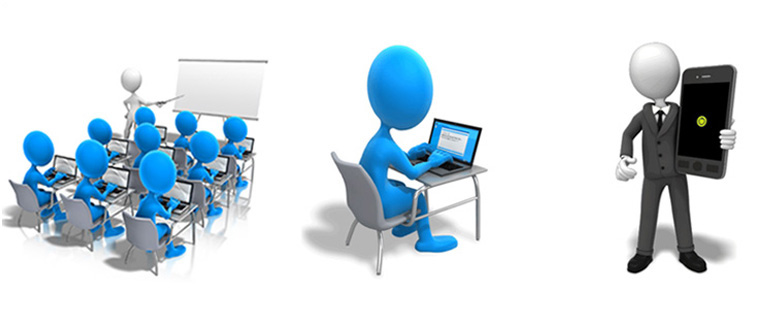How Blended Learning Benefits Adult Learners — A Deep Dive!

Modern businesses are dynamic and constant innovation is crucial to stay ahead of the curve. Constant upskilling and reskilling have become indispensable and learning and development have become pivotal for both individual growth and organizational success. Traditional one-size-fits-all approaches to learning often fall short, especially when it comes to adult learners. This is where blended learning emerges as a game-changer, offering a flexible and personalized approach that caters to the unique learning needs of adult learners. Let's delve into what blended learning entails and how it significantly benefits adult learners in the corporate world.
Blended Learning for Adult Learners — Deep Dive!
Adult Learners are Different from Young Learners:
- Prefer self-directed learning
- Have past life experiences
- Look for ‘What’s in it for me’
- Have time constraints
- Have a problem-solving orientation
Here’s How Blended Learning Can Benefit Adult Learners:
- Offers Flexibility and Convenience
- Crafts Personalized Learning Paths
- Enhances Learner Engagement
- Supports Collaborative Learning
What is Blended Learning?
For those who are new to the concept, blended learning is a holistic approach that combines traditional face-to-face instruction with online learning components. It integrates various learning formats such as eLearning modules, virtual classrooms/virtual instructor-led training (VILT), interactive workshops, and microlearning lessons. This dynamic blend provides learners with the flexibility to engage in learning activities at their own pace and convenience while still benefiting from instructor-led sessions and peer collaboration. The blended approach offers you the scope to craft personalized learning journeys for your learners and ensure the desired learning outcomes.

What are the Key Characteristics of Adult Learners?
Understanding the characteristics of adult learners is crucial for designing effective learning experiences. Here are some key traits that distinguish adult learners:

1. Prefer Self-Directed Learning: Adults prefer taking control of their learning journey, setting their goals, and choosing the most suitable learning methods. Unlike children or young students, who need a certain level of guidance or handholding, adults thrive in self-directed learning environments where they feel empowered to take charge of their learning.
2. Have Past Life Experiences: Adult brains are not plain slate. They bring a wealth of knowledge and experiences from their personal and professional lives, which influence their decision-making. Remembering this aspect while designing learning content for adult learners can help you achieve the desired results.
3. Look for “What's in it for Me”: Young learners are enthusiastic about learning anything new. This is not the case with adult learners. They are motivated by the practical application of learning. They seek relevance and value, wanting to know how the learning experience will benefit them personally or professionally.
4. Have Time Constraints: Balancing work, family, and other responsibilities, adult learners have limited time for structured learning activities. They can’t spend long hours attending training sessions to learn something that might help them in the future. Flexibility in learning schedules is crucial for their engagement.
5. Have a Problem-Centered Approach: Unlike young learners who are curious about learning new things, adults often approach learning as a means to solve real-world problems and improve their performance in specific areas. They prefer targeted learning that can help them counter real-time work challenges and ease their day-to-day work life.
→ Shop Now — Blended Learning Guide to Boost Employee Performance [eBook]
How Blended Learning Can Cater to the Unique Learning Needs of Adult Learners?
Blended learning aligns perfectly with the needs and preferences of adult learners, offering several benefits that enhance their learning experience. Let’s see how:
Offers Flexibility and Convenience
The online components of blended learning allow adult learners to access learning materials anytime, anywhere, suiting their busy schedules and time constraints. eLearning modules facilitate self-paced learning and allow learners to take charge of their learning as these learning modules offer clear and simple navigation. They can skip certain modules or revisit modules according to their learning preferences.
Short yet power-packed microlearning lessons in the form of videos, eBooks, flashcards, podcasts, and more are great for just-in-time learning and are great for fixing quick doubts during work and ensuring greater productivity and enhanced performance. These snackable learning nuggets are handy tools and charm adult learners as they can apply the learning immediately.
Crafts Personalized Learning Paths
Blended learning enables customization based on individual learning styles, preferences, and prior knowledge. Learners can choose modules or activities that align with their specific goals and interests. This freedom to choose the desired learning formats provides a sense of autonomy to adult learners and leads to better learning.
The learning modules under the blended learning umbrella are hosted on learning management systems (LMS). These LMSs provide data-driven learning analytics that can be used by training managers to craft personalized learning journeys for individual learners. Training managers can choose from a large variety of learning formats to customize training based on unique learning needs, styles, and preferences. For instance, crucial ‘need-to-know’ concepts can be delivered through VILT, where learners have access to the trainer to clarify doubts if any, and online learning materials covering ‘nice-to-know’ content around the topic can be shared with learners to go through at their convenience.
Enhances Learner Engagement
Blended learning allows you to choose a variety of learning formats and this variety is beneficial to design a learning program that garners learner attention and keeps them engaged throughout the entire learning journey. You can also incorporate various interactivities and real-world application scenarios to make learning an enjoyable experience. By incorporating real-life case studies, simulations, gamification elements, and practical exercises, blended learning makes learning more relevant and applicable to adult learners' professional challenges and goals.
Scenario-based eLearning courses mimic real-world situations and allow learners to hone their critical thinking, problem-solving, and decision-making skills. These real-world scenarios allow learners to learn in a risk-free environment and boost their confidence to face everyday work challenges. This caters to their trait of looking at learning as a tool to resolve problems.
Supports Collaborative Learning
Adult learners are interested in learning that helps them tackle challenges in their day-to-day operations. The blended learning approach offers scope for diversified learning that’s crucial to survive unprecedented work-life challenges.
Blended learning offers scope for collaborative and social learning, must-haves to facilitate the active participation of modern learners. Blended learning platforms such as virtual classrooms, online discussion forums, online communities, and collaborative projects foster peer-to-peer interaction and knowledge sharing, leveraging the diverse experiences of adult learners. This not only boosts learning but also enhances team spirit.
The blended learning approach can help you build a learning culture within your organization. Watch this video to explore how it does so.
Blend it Right to Boost Adult Learning for Business Success
Blended learning is a powerful strategy that caters to the unique characteristics and preferences of adult learners in the corporate world. By offering flexibility, personalization, real-world relevance, collaboration opportunities, and continuous feedback, blended learning not only enhances the learning experience but also contributes significantly to individual skill development, employee engagement, and overall organizational growth. Embracing blended learning is not just a trend but a strategic investment in cultivating a culture of lifelong learning and innovation within your workforce.
It's all about making the best blend of learning formats that’s just right for training your employees. Need more guidance into getting things right? Here’s an eBook that’ll take you through the nuances of blended learning. Grab your copy now and boost employee performance.




![Blended Learning for Corporate Training: Overcome 3 Implementation Challenges [Infographic]](https://blog.commlabindia.com/hubfs/Imported_Blog_Media/blended-learning-implementation-challenges-solutions-info-v1.jpg)
